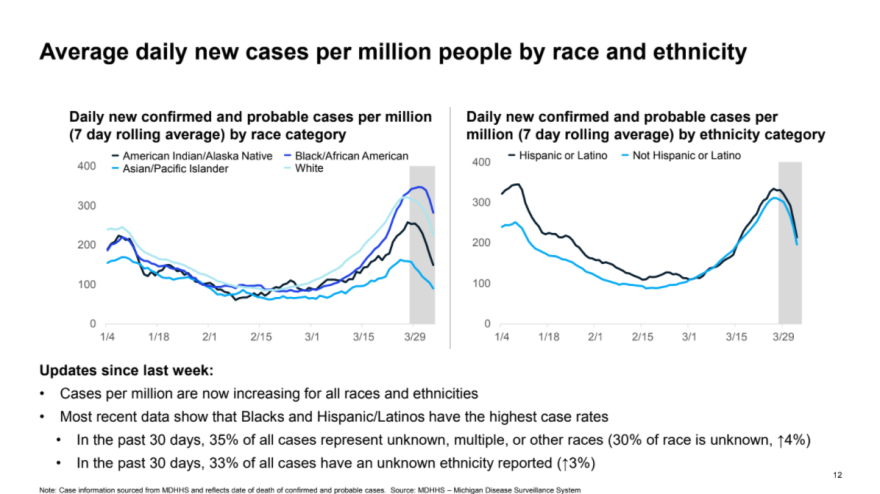Michigan continues to lead the country in dismal COVID-19 indicators, according to a Wednesday update by the state's Department of Health and Human Services. The state update used data as of April 3.
Over the past week, Michigan has had the highest number of cases and the highest case rate in the country.
Michigan's case rate has gone up by 375% since a low on February 19.
This is reflected at the region and county-level too: all regions saw an increase in their case rates.
The positivity rate was in the double digits for 63 out of Michigan’s 83 counties in the last week, the highest ones in the Thumb and parts of the northern Lower Peninsula. And the 7-day average positivity rate statewide, 15.6%, is the highest it has been since April 2020, when testing was not as robust as it is now.
Increases are seen among most ages, races and ethnicities. But the most recent numbers show that cases affecting Black Michiganders have crept upwards and beyond their white counterparts and is starting to show disparity, according to state epidemiologist Sarah Lyon-Callo. Hispanic and Latino residents are also seeing high case rates.

Cases affecting 20 to 29-year-olds jumped up by 73% in the past week. But 30 to 39-year-olds had the biggest difference since the February 29 low at a 433% rise.
Active outbreaks also went up by 14% since last week. Most have been associated with K-12 schools.
Cases and clusters have also been seen across 15 youth sports settings since January 2021. The three highest are basketball (376 cases and 100 clusters), hockey (256 cases and 52 clusters) and wrestling (190 cases and 55 clusters).
This has been a huge concern for the director of the U.S. Centers for Disease Control, who said Michigan should implement restrictions on indoor youth sports.
However, during the case update, restrictions were not brought up.
MDHHS Director Elizabeth Hertel said the department's focus is on getting people vaccinated. As of Wednesday, more than 37% of Michigan residents age 16 and up have received at least one vaccine dose.
MDHHS officials will, however, continue to monitor outbreaks among young people and athletes.
Lyon-Callo said Michigan has a testing program with school sports and has shipped out antigen COVID-19 tests. She said MDHHS has trained “every school in the state as well as a number of sports entities to be able to conduct testing.” She also said they are encouraging the use of masks, if possible.

Hertel added that MDHHS is encouraging school districts to move middle schools and high schools to virtual learning for one or two weeks after spring breaks to slow the spread of the variant among young age groups.
As of April 3, Michigan had the highest increase in COVID-19 related hospital admissions among its Midwestern neighbors.
More than 3,300 people are currently hospitalized with COVID-19 in Michigan and those numbers are going up in all regions of the state. Deaths lag behind but are inching upwards with a 75% increase since the March 9 low.
According to MDHHS, Region 6, which covers parts of West Michigan, saw its hospitalizations double in seven days.
Lyon-Callo said Michigan Medicine made a grim forecast based on current growth trends.
“They estimate that by April 12, we could be at more than 4,500 hospitalizations for COVID-19 which exceeds our spring 2020 peak census,” she said. “And they're projecting that we could be over 800 patients in the ICU, which is higher than our winter peak ICU census.”
People 40-49 saw a 60% increase in the past week, the biggest one among age groups. But since the lowest point for hospitalizations on February 28, it was 50 to 59-year-olds that saw a jump of 653% in average daily hospital admissions.
Age groups that have been vaccinated early, like 70 to 79-year-olds, have decreased in admissions since the last winter surge.
Hertel says some hospitals are beginning to look at implementing surge plans but are “well equipped” to handle these surges.
“We've seen them do it a number of times now, unfortunately, and we will remain here, ready to support them in whatever they need,” she said.






